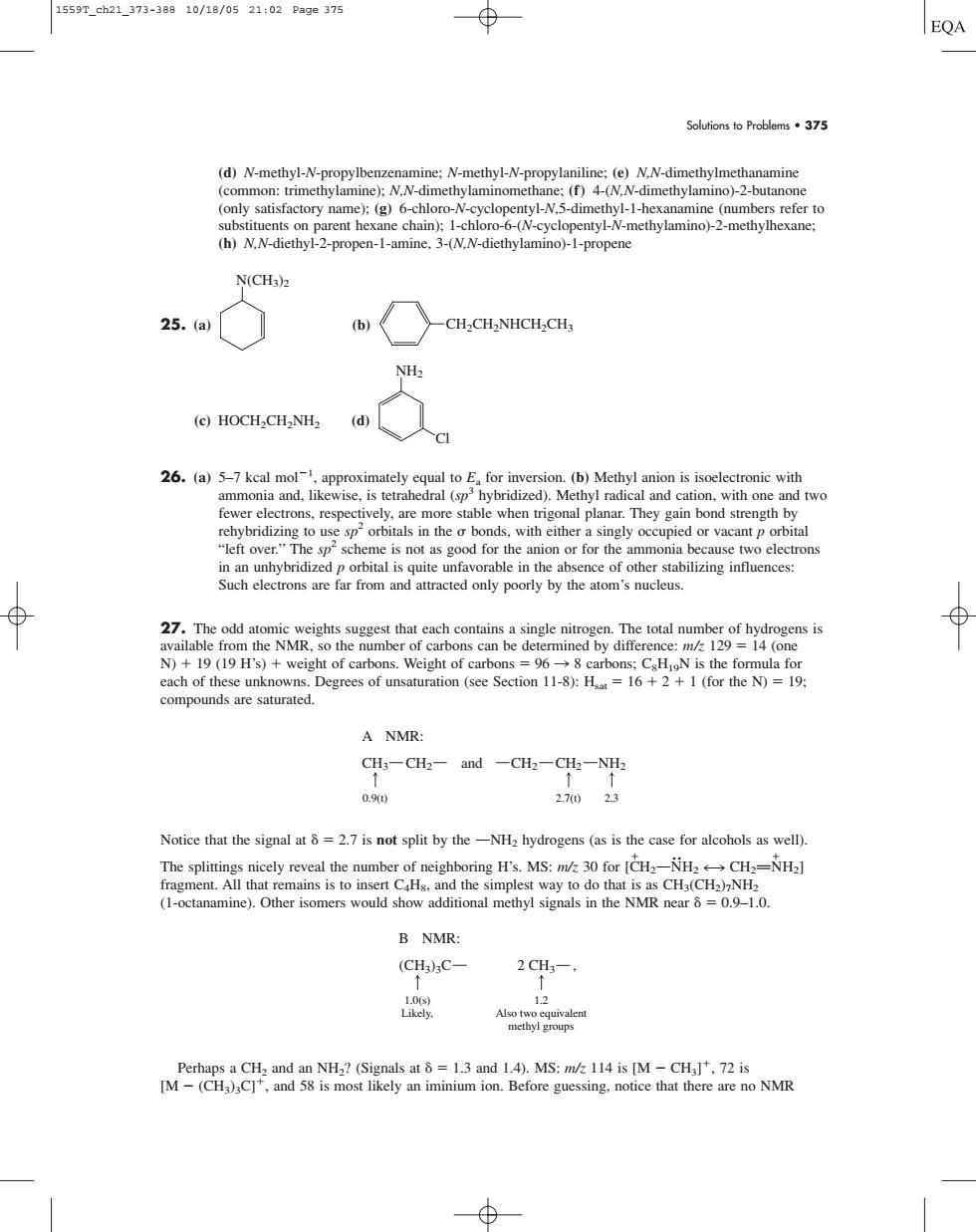正在加载图片...

1559T_ch21_373-38810/18/0521:02Pa9e375 EQA Solutions to Problems.375 (h)NN-diethy-propen-1-amine,3-(N.N-diethylamino)-1-propene N(CH3)2 25.(a) -CH,CH,NHCH,CH: NHz (c)HOCH,CH2NH2 26.(a)5-7 kcal mol-1 rctrons,respectively,are more stable when tgonal planar.They gain bond strengn by in the o b with eithe a singly occup in an unhybridized p orbital is quite unfavorable in the absence of oter Such electrons are far from and attracted only poorly by the atom's nucleus. N+1919Hs+ can be d ula fo each of these unknowns.Degrees of unsaturation (see Section 11-8):H16+2+1(for the N)=19: compounds are saturated A NMR: CH-C-ad一c,-cH-N 090 27023 Notice that the signal at=2.7 is not split by the-NH hydrogens (as is the case for alcohols as well). 2-NH.J B NMR (CH3)C- 2CH:- Solutions to Problems • 375 (d) N-methyl-N-propylbenzenamine; N-methyl-N-propylaniline; (e) N,N-dimethylmethanamine (common: trimethylamine); N,N-dimethylaminomethane; (f) 4-(N,N-dimethylamino)-2-butanone (only satisfactory name); (g) 6-chloro-N-cyclopentyl-N,5-dimethyl-1-hexanamine (numbers refer to substituents on parent hexane chain); 1-chloro-6-(N-cyclopentyl-N-methylamino)-2-methylhexane; (h) N,N-diethyl-2-propen-1-amine, 3-(N,N-diethylamino)-1-propene 25. (a) (b) (c) HOCH2CH2NH2 (d) 26. (a) 5–7 kcal mol1 , approximately equal to Ea for inversion. (b) Methyl anion is isoelectronic with ammonia and, likewise, is tetrahedral (sp3 hybridized). Methyl radical and cation, with one and two fewer electrons, respectively, are more stable when trigonal planar. They gain bond strength by rehybridizing to use sp2 orbitals in the bonds, with either a singly occupied or vacant p orbital “left over.’’ The sp2 scheme is not as good for the anion or for the ammonia because two electrons in an unhybridized p orbital is quite unfavorable in the absence of other stabilizing influences: Such electrons are far from and attracted only poorly by the atom’s nucleus. 27. The odd atomic weights suggest that each contains a single nitrogen. The total number of hydrogens is available from the NMR, so the number of carbons can be determined by difference: m/z 129 14 (one N) 19 (19 H’s) weight of carbons. Weight of carbons 96 n 8 carbons; C8H19N is the formula for each of these unknowns. Degrees of unsaturation (see Section 11-8): Hsat 16 2 1 (for the N) 19; compounds are saturated. Notice that the signal at 2.7 is not split by the ONH2 hydrogens (as is the case for alcohols as well). The splittings nicely reveal the number of neighboring H’s. MS: m/z 30 for [CGH2ON .. H2 mn CH2PN G H2] fragment. All that remains is to insert C4H8, and the simplest way to do that is as CH3(CH2)7NH2 (1-octanamine). Other isomers would show additional methyl signals in the NMR near 0.9–1.0. Perhaps a CH2 and an NH2? (Signals at 1.3 and 1.4). MS: m/z 114 is [M CH3] , 72 is [M (CH3)3C], and 58 is most likely an iminium ion. Before guessing, notice that there are no NMR B NMR: (CH3)3C 1.0(s) Likely, 1.2 Also two equivalent methyl groups 2 CH3 , CH3 A NMR: 0.9(t) 2.7(t) 2.3 CH2 and CH2 CH2 NH2 NH2 Cl CH2CH2NHCH2CH3 N(CH3)2 1559T_ch21_373-388 10/18/05 21:02 Page 375��������